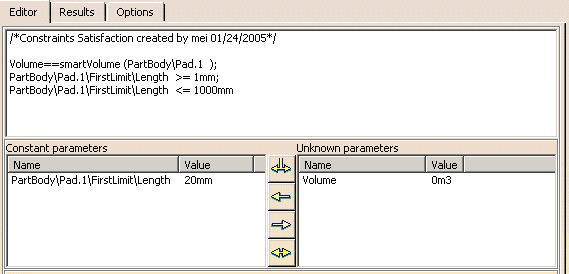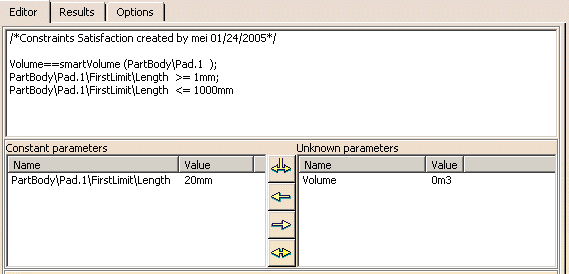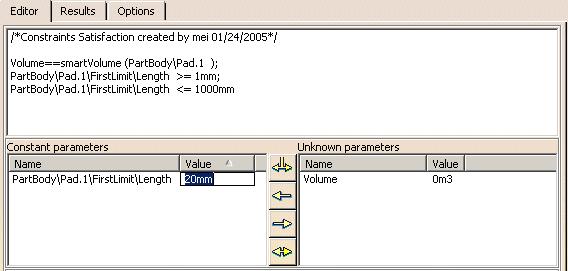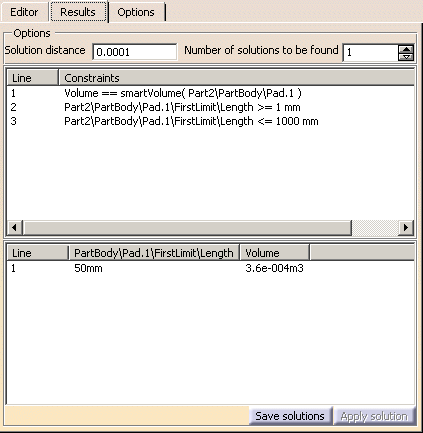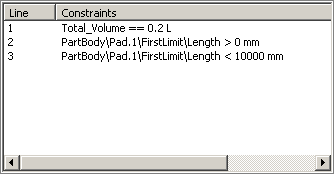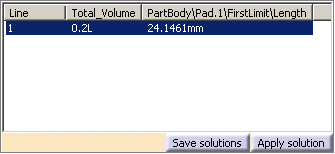Algorithm
- Precision: Enables you to define the precision of the
results (i.e the number of decimal digits after the decimal point.)
This precision is used when comparing 2 numbers. This option defines
whether they are equal or not. When dealing with units, the comparison
is made on the basis of the MKS value of parameters.
Note that if the precision is set to 0 the precision is set to 1e-10.
The black box precision is set to 1e-11. This may result in a very long
computation time to solve the set of equations.
- Use Gauss method for linear equations: Accelerates the
solve operation when working with linear equations.
|
 |
Termination criteria
- Maximum computation time (sec.): Enables you to indicate
the computation time. If the indicated time is equal to 0, the
computation will last until a solution is found.
- Show 'Stop' dialog: If checked, displays a "Stop" dialog
box that will enable you to interrupt the computation.
- Generate expanded error description: Enables you to get
detailed information about errors if they occur.
|
 |
Note that the dialog box STOP is
displayed only after a few seconds. If the computation is performed
quickly, it is not displayed. |
| |
|
| Black
boxes algorithm: You have the choice between 2 algorithms. If your
problem behaves like quadratic functions, select Quadratic
approximation. |
 |
|
| |
|
Black
boxes parameters
- Precision (for black boxes):
A real number taken from the interval [1e- 10, 0,1]. This number has an
influence on the accuracy of the solution found.
- Maximal number of black boxes calls:
This option allows you to limit the number of measures calculation.
(equivalent to a time limit.)
- Number of attempts: This
option is only used for sets of constraints with more than one
variable. This option changes the number of start points used by the
solver. For instance, for a 2-dimensional problem, the following number
of calls will be performed:
Number of attempts: 1- > 3 start points
Number of attempts: 2- > 9 start points
Number of attempts: 3- > 27 start points
- Use unimodal
interval: This option allows you to use a special
information about the interval of unimodality.
- Minimize the number of black boxes calls: If checked:
- Enables to minimize the number of black boxes evaluations.
|
- If you need several solutions, the fact that the solutions
found will be close to each other is not guaranteed.
|
In both cases (option checked or not), solutions will be found.
- Width: This parameter sets
the minimal width of the interval of unimodality for measures. For
linear, quadratic and any monotonic measure, this value can be set to
1e 19. In a common case, the greater this value, the quicker the solver
finds the solutions. However if you are not sure about the monotonicity
of the problem, do not use this option.
- Cache size: This option
allows you to choose the size of internal black boxes caches. Decrease
this value only if you do not have enough memory. Increase this value
if you have enough memory to reduce the computation time.
|
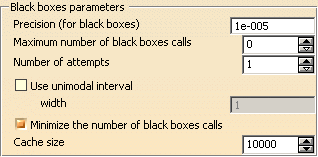 |
![]() )
icon. It is made up of three tabs.
)
icon. It is made up of three tabs.